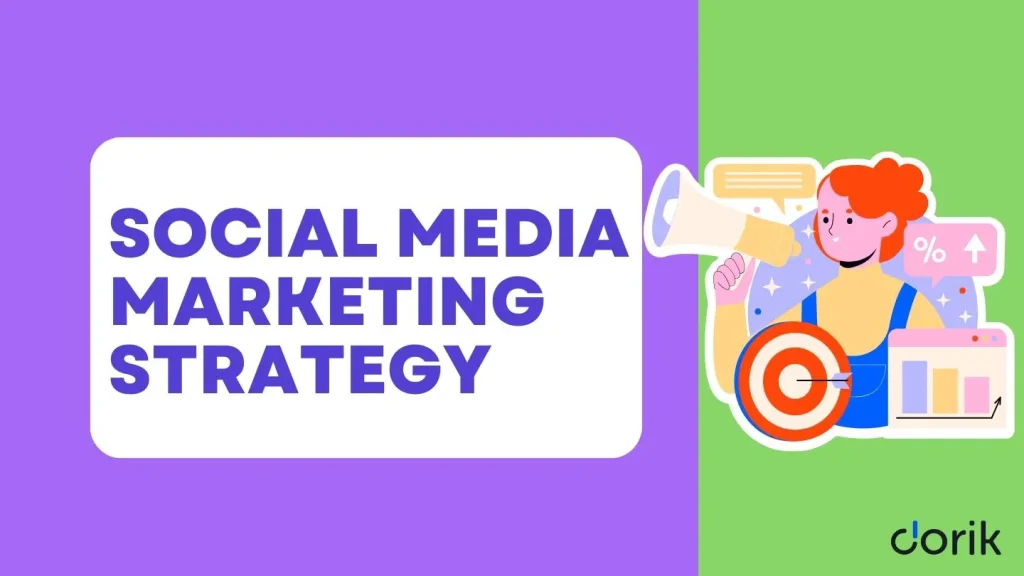Social Media Marketing Strategy :
Learn how to create an effective social media marketing strategy with this detailed example, including actionable steps, real-world cases, and best practices to boost your online presence and engagement.

1. Define Your Goals and Objectives
Begin by establishing clear, measurable, and attainable goals for your social media efforts. Common objectives include increasing brand awareness, driving website traffic, generating leads, or boosting sales. Align these goals with your overall business objectives to ensure consistency and focus.
Example: A local boutique aims to increase brand awareness by growing its Instagram followers by 25% over the next three months.
2. Identify Your Target Audience
Understanding your target audience is crucial for creating content that resonates. Develop detailed buyer personas that include demographics, interests, behaviors, and pain points. This information will guide your content creation and platform selection.
Example: A fitness apparel company targets health-conscious women aged 18-35 who are active on Instagram and Facebook.
3. Conduct a Competitive Analysis
Analyze your competitors’ social media presence to identify their strengths, weaknesses, and the strategies they employ. This analysis can reveal opportunities for differentiation and areas where you can outperform them.
Example: A tech startup observes that competitors are not utilizing LinkedIn effectively, presenting an opportunity to share industry insights and establish thought leadership on the platform.
4. Choose the Right Platforms
Select social media platforms that align with your target audience and business goals. Focus your efforts on platforms where your audience is most active to maximize engagement.
Example: A B2B software company prioritizes LinkedIn and Twitter for sharing professional content, while maintaining a presence on Facebook for broader reach.
5. Develop a Content Strategy
Create a content plan that outlines the types of content you will share, the themes or topics to cover, and the posting frequency. Ensure your content provides value, aligns with your brand voice, and encourages engagement.
Example: A travel agency plans to post destination highlights, travel tips, customer testimonials, and promotional offers on a weekly basis.
6. Create Engaging and Shareable Content
Produce high-quality content that captures attention and encourages sharing. Utilize a mix of formats such as images, videos, infographics, and articles to cater to different preferences.
Example: A culinary blog shares short recipe videos on TikTok and Instagram Reels, attracting food enthusiasts and encouraging user-generated content.
7. Implement a Content Calendar
Organize your posting schedule with a content calendar to maintain consistency and ensure timely delivery of content. This tool helps in planning ahead and coordinating campaigns effectively.
Example: A fashion retailer uses a monthly content calendar to schedule posts around seasonal promotions, new arrivals, and fashion events.
8. Engage with Your Audience
Actively interact with your followers by responding to comments, messages, and mentions. Engagement fosters a sense of community and builds stronger relationships with your audience.
Example: A coffee shop responds promptly to customer inquiries on Facebook and shares user-generated photos of their beverages, enhancing customer loyalty.
9. Monitor and Analyze Performance
Regularly review your social media metrics to assess the effectiveness of your strategy. Key performance indicators (KPIs) may include engagement rate, reach, click-through rate, and conversion rate. Use these insights to refine your approach and improve results.
Example: An online bookstore tracks the performance of its social media campaigns using analytics tools to identify which types of posts drive the most sales.
10. Stay Updated with Trends and Best Practices
Social media is constantly evolving, so it’s essential to stay informed about the latest trends, algorithm changes, and best practices. This knowledge allows you to adapt your strategy and maintain relevance.
Example: A beauty brand adopts emerging trends like live streaming tutorials and collaborates with influencers to reach a wider audience.
Real-World Example: CeraVe’s Digital Marketing Success
CeraVe, a skincare brand, has effectively utilized social media to boost its brand awareness and engagement. By focusing on science-backed content featuring dermatologists and leveraging platforms like TikTok and Instagram, CeraVe has resonated with consumers seeking trusted, research-based products. Their humorous marketing campaigns, such as the Super Bowl ad with actor Michael Cera, have further enhanced their appeal.
Best Practices for Social Media Marketing
- Authenticity: Maintain a genuine and consistent brand voice to build trust with your audience.
- Visual Appeal: Use high-quality visuals to capture attention and convey your brand message effectively.
- User-Generated Content: Encourage and share content created by your customers to build community and social proof.
- Hashtags: Utilize relevant hashtags to increase the discoverability of your content.
- Analytics: Leverage analytics tools to gain insights into your audience’s behavior and preferences.
Conclusion
Developing a robust social media marketing strategy involves setting clear goals, understanding your audience, creating engaging content, and continuously analyzing performance. By following this comprehensive example and adhering to best practices, you can enhance
